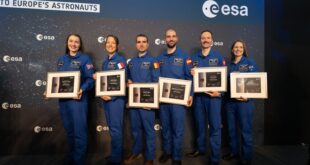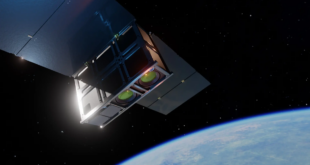by Dr Mathieu Bailly

I have just come back from the IAC 2021 in Dubai where I enjoyed advocating for end-to-end data security for commercial “newspace” missions. While it was so great to meet colleagues face-to-face and discover the energetic city of Dubai, it bothered me when booking my plane tickets that this trip was to be accounted in my annual carbon footprint. An average Swiss citizen is responsible for an unsustainable 14 tons eq CO2 / year, my flights to Dubai represented about 1.6 tons, which is quite significant and certainly did not help to reduce it.
Every single ton counts
The latest IPCC report has further detailed the consequences of the growing concentration of CO2 in the atmosphere, calling for immediate action to avoid the Planet to turn into “hell” as phrased by Antonio Guterres, UN Secretary-General. It means that there is a fixed amount of greenhouse gases we can afford to release into the atmosphere in order to limit the disastrous effects of global warming. In other words: every ton counts.
Space will make no exception!
The only way out is to become carbon neutral as soon as possible. Transitioning to a carbon-neutral society will require that all sectors of activity be able to 1. calculate and 2. reduce their carbon footprints towards neutrality. Every sector: education, healthcare, transportation, agriculture, construction, etc. Space included. Yes. Why should space be an exception? I cannot think of any valid reason. And definitely not by arguing that the emissions of space missions are small compared to other sectors for example civil aviation (remember: every ton counts).
What is the carbon footprint of a space mission?
Sounds like a simple question but after a search online, I could not find a clear answer. The topic was first touched by ESA in 2009 and followed by a couple of Life Cycle Analysis (LCA) studies by Deloitte or Pré for ESA in the 2010’s. Sadly even in these technical reports, I was not able to find an estimation of the impact of a given mission in tons of eqCO2, which was quite frustrating. The only figure I was able to get was from an article in The Guardian about space tourism quoting Eloise Marais, an associate professor of physical geography at University College London. Marais estimates that one rocket launch emits 200-300 tons of carbon dioxide. That’s a start but it remains insufficient to estimate the footprint of an entire mission from Phase A to F.
Space tourism: the tip of the iceberg

The controversy related to space tourism shed the light on the environmental impact of manned space flights. While it made the connection between “carbon impact” and “space missions” for the first time in the public domain, the debate primarily focused on the unfair privileges of the wealthy, not touching upon the general footprint of the industry as a whole. With up to 100’000 satellites to be launched, this may become more and more significant.
Sustainability in.. space
The space industry does care about sustainability, but not in the meaning of carbon neutrality. Initiatives in the US or in Europe related to the “sustainable use of space” refer to the issue of space debris, now threatening future missions and requiring action. A topic that rightfully deserves all our attention -just like cybersecurity- but that should by no means occult the other possible meaning of the word “sustainable” here on Earth.
Where is the first carbon-neutral space mission?
One could expect in the context of climate emergency that significant efforts would be ongoing to better estimate and reduce the carbon footprint of developing, launching, operating, and decommissioning orbital systems. One would expect space agencies and industrial leaders to announce the first carbon-neutral space mission with disruptive innovation financed by massive private-public partnerships. Similar to what the aviation industry is doing today around hydrogen.
Is anybody concerned?
That is not exactly what is happening. At the IAC 2021, dozens if not hundreds of presentations and round tables took place, in my best knowledge (please correct me!) none were addressing the carbon impact of space missions. Not a single stand referred to it, even the non-profit organizations, more likely to engage on such environmental topics. Agencies are focusing their efforts on launching new satellites with higher capabilities to better track greenhouse gases, see for example the website of ESA’s climate office. Industry leaders communicate about sustainability (e.g. Ariane Group precisely mentioning the goal of neutrality) but always with the risk of greenwashing as words and promises rarely turn into actions.
When are we making space sustainable.. on Earth?
As the COP26 is just getting started, it is crucial that the space industry recognizes not only its contributions to collecting the data needed for tracking climate change but also its contributions to climate change itself. Considering the expected growth of the market -space tourism or not-, sustainability in space should be equally important as sustainability on Earth.
This article was published first at https://www.linkedin.com/pulse/wanted-carbon-neutral-space-mission-mathieu-bailly and its republished with permission from the author.

Dr Mathieu Bailly, VP Space & Iot, CYSEC SA, a Swiss cybersecurity company. He oversees product development and activities related to the fast-growing markets of the Internet of Things, Space and Maritime, where cybersecurity is not yet regulated and has become a major concern. Mathieu holds a MSc in Materials Science from the Grenoble Institute of Technology in France and a PhD in Chemical Engineering from Queen’s University, Canada.





